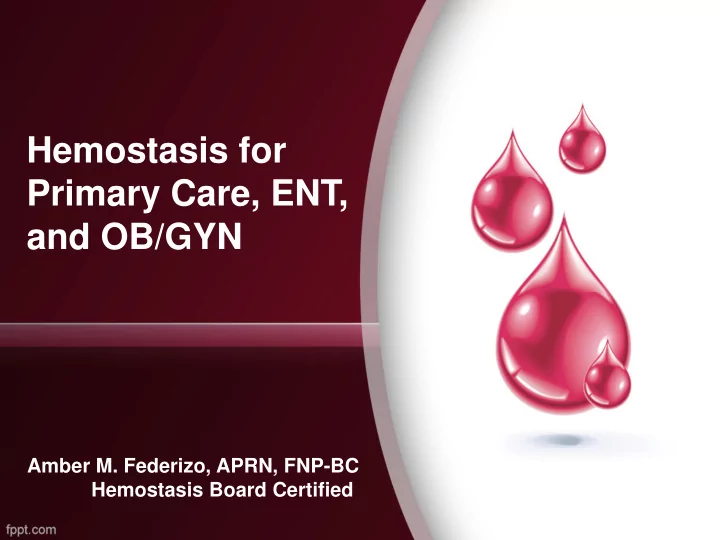

. Hemostasis for Primary Care, ENT, and OB/GYN Amber M. Federizo, APRN, FNP-BC Hemostasis Board Certified .
. Pre-Questionnaire Link • https://goo.gl/forms/MGUJAM5GRyjt0eqO2 .
. Introduction • Hemostasis and Thrombosis Center of Nevada • Nevada’s only federally recognized treatment center. • Comprehensive care • CDC studies • Background .
. Primary Care/ENT/OB/GYN • Forefront of encounters for easy bruising, epistaxis, and uterine bleeding. 16 years .
. Hemophilia • Inheritance • Spontaneous • Acquired • Reduced clotting factors – levels can be discordant with phenotypic expression .
. Diagnosis • PT, PTT (if prolonged) Factor activity testing. • Problematic for females – Definitive testing. Activity levels and genetics .
. PTT Factor FVII (7) PT 8, 9,11,12 About 12 seconds About 25-39 seconds Prolongation of both Factor 1, 2, 5, 10 .
. Treatment • Infusions of clotting factors 100% .
. Case #1 • 8 year old male, history of easy bruising and occasional nosebleeds • Presented to PCP with left knee swelling/warmth and pain. • Despite conservative methods pain and swelling worsened • Referred to orthopedics • Orthopedics pursued needle aspiration of the knee – fluid and blood • Discharged. Knee worsened in 48 hours. PT, PTT slightly prolonged. Hematologist/Oncologist consult notes as not significantly delayed. Orthopedics completes second needle aspiration of the knee. • Discharged again. Presented in 24 hours without ability to walk. Knee swollen to 2-3 times normal hot to the touch and extremely painful. PT, PTT on admission slightly prolonged federally designated hemophilia treatment center consulted. Diagnosed with Mild Hemophilia A. Treated with daily factor for one month and PT. .
. Case #2 • 28 year old female G1P0 develops bleeding at 28 weeks gestation. • Family history of Hemophilia (father) • Bleeding increases over the next few hours. • Patient provides family history and assured bleeding could not be due to hemophilia since she is female. • Bleeding becomes perfuse, miscarries and requires 5 units of PRBC • Family self refers to HTC • Determined to have Hemophilia a 17%. • Given plan for factor as she is non-responsive to DDAVP .
. von Willebrand Disorder • Most common • Mucocutaneous bleeding • Delays in diagnosis – Female gender – Initiation of hormones prior to testing – Cautery of nasal mucosa prior to testing .
. Von willebrand Platelet GpIIb/IIIA VWF GpIb CR Endothelium .
. Von willebrand Platelet GpIIb/IIIA VWF GpIb CR Endothelium .
. Diagnosis • A complete von Willebrand Panel includes – VWF antigen – VWF ristocetin cofactor activity – FVIII (8) activity – Multimeric analysis 1.Pre-analytic variables – Processing, anxiety (fear of needles), prescribed hormones, .
. Von Willebrand Type 1 Platelet GpIb CR Endothelium .
. Treatment • Anti-fibrinolytics – preferred – Lysteda 25mg/kg per dose average adult 650mg PO TID – Amicar 50mg/kg/dose PO every 6 hours. • Hormones • DDAVP – 2B/3/Non-responsive Type 1 • VW Factor concentrate .
. Case #4 32 year old family and personal history of heavy menstrual periods - started on hormones with some improvement but still with heavier periods. - Anemia with some improvement - Discontinues hormones to become pregnant. Symptoms improve dramatically. - Delivers without complications but experiences a postpartum hemorrhage and develops a delayed perineal hematoma. PT, PTT normal. - Referred to hematology. VWF ag 10% VWF Rco 10% FVIII 55% .
. Case #5 • 15 year old male • Epistaxis 2-3 times a week between 10-30 minutes in duration x 2 years • Denies picking • Referred to ENT for epistaxis • Cauterized x 8 • Episodes worsened • Presented to ER with 4 hour profuse bleeding. • PT, PTT normal. Hemoglobin 8. Consult with HTC patient found to have VWD type 2M. Started on intranasal amicar, personal lubricant, and on demand treatment with VWF concentrate with improved control of epistgaxis .
. Case #6 • 50 year old female • History of epistaxis, easy bruising, heavy periods until menopause at age 45 • Complains of occasional epistaxis • Undergoes colonoscopy with biopsy and polyp removal. Does well and is discharged. • 4 days later presents with GI bleed. Further testing reveals Type 1 VWD. Patient is treated with VWF concentrates and pre-treated for all future procedures. .
. Case #7 • 3 year old with epistaxis • Tested for VWD comes back WNL • Undergoes cautery with some improvement • Undergoes clearance for Tonsillectomy and Adenoidectomy. PT PTT normal platelet count on CBC normal • Undergoes surgery. Day 10 has perfuse bleeding. Attributed to sloughing of eschar. Continues to ooze for 21 days. • Seen by HTC initial work-up negative. Platelet aggregation consistent with Bernard solier. .
. What can be done • Obtain testing at presentation before intervention – VWD Quest – VWD LabCorp Strong clinical suspicion beyond normal levels warrants a referral. POC for remote patients yearly with interimn follow-up and management with PCP. .
. Post Questionnaire Link • https://goo.gl/forms/6QkGglp64kbPeTV72 .
Recommend
More recommend